Now Curating Virtual Exhibit
The San Diego Archaeological Center houses many prehistoric and historic collections from the San Diego County and adjacent regions. The Center is equipped with over 5,000 square feet of vault space that allow us to provide long-term curation and care for a wide range of archaeological materials, including artifacts, ecofacts (unmodified bone & shell, and charcoal samples), maps, photographs, and site records. Partnering with local colleges and universities provides a setting for volunteers and students interested in archaeology to gain hands-on experience working with archaeological collections.
How Does the SDAC Acquire Collections?
Most of the collections that are curated at the Center come to us from Cultural Resource Management (CRM) firms who have done work for private companies, or federal, state and local government agencies. These CRM firms work with developers around the county to make sure that construction is done using ethical and sustainable methods and that archaeological sites are protected and documented. Once their work is complete, CRM firms curate collections at the Center for long-term preservation and care.
How is a Collection Curated?
Curating a collection involves many steps: reading the report, inventorying and organizing the artifacts/ecofacts, updating the catalog, printing labels and attaching them to the artifact/ecofacts bags, printing box labels and inventories, and creating collection documentation like the master catalog. An executive summary is filled out for each collection that documents the details of the project before it came to the Center and everything that happens to it after it arrives. Collections are curated by staff, volunteers, and interns.
Take a closer look at the collections currently being curated at the Center in this virtual exhibit, Now Curating.
Project Name: Cisterra Sempra Office Tower Project
Location: San Diego City
Year of Excavation: September 11-20, 2013; Oct 7, 2013-August 14, 2014
Overview of the Site
The location of the Cisterra Sempra Tower Project was in the East Village neighborhood of San Diego, California. The project area included most of a city block. The site had nine historic features, including four small refuse deposits, three historic wells, one historic cistern, and one privy. The time period of the artifacts found was from the early 1800s through the 1940s.
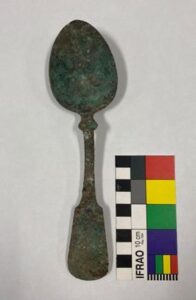 Kitchen Ware
Kitchen Ware
Various kitchen utensils were found on site, including dishware made mainly of ceramics and a few metal utensils. To be more precise, the types of ceramics include ironstone, refined earthenware, stoneware, and porcelain. There was also a large number of pieces that were hotel ware. These ceramic items were designed to endure frequent and rigorous use. The ceramics were intentionally designed to be simple and come in standard sizes. Merchants purchased this tableware due to its affordable price.
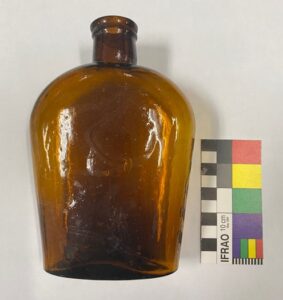 Beverages
Beverages
This collection contains a variety of bottles, including alcoholic and non-alcoholic beverages. Alcoholic drinks were popular in the 1800s. Individuals constantly bought alcohol and consumed a lot. Alcoholic beverages were popular because they stayed unspoiled for a longer time compared to non-alcoholic drinks. Water often made people ill because the correct water purification steps were not known at that time. It made people favor alcohol more than water because the water was more harmful than alcohol. A small number of these bottles and jars were machine-made. Some bottles contained mineral water, soda, and water too. The alcoholic drinks that people would purchase were beer, wine, and champagne. Almost all of the bottles are glass. Their colors include aqua, clear, green, olive, cobalt, and dark olive.
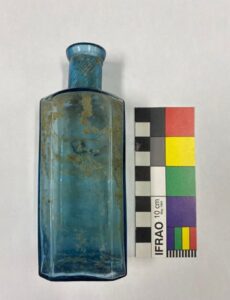 Medicine Products
Medicine Products
The archaeological site had many medicine bottles. There were many different manufacturers of the bottles. The companies were located all around the United States. The medicine bottles are made of glass. The bottle’s colors were aqua, cobalt, clear, and amber. The sizes of the medicine bottles ranged from small to large. A large portion of the bottles had rectangular and square bodies. In the 1800s, it was common to find people taking medicines with cough syrup and cocaine. Cough syrup was used because it contained opium. Opium is used to treat pain but can treat coughs and diarrhea. Throughout the 1800s, both drugs were widely used for various purposes.
Conclusion
The area of the site was used for multi-family residential housing from the late 1800s through the 1920s. By the 1930s, the area changed to mixed commercial and industrial use. Since the area was used for multiple housing like hotels and other structures, a wide variety of artifacts was found.
Written by Collections Intern Nadia Dawood
Edited by Collections & Library Tech Suzanne Moramarco
Further Reading
The Revolution of American Drinking, US History Scene
https://ushistoryscene.com/article/american-drinking/#:~:text=In%20the%20days%20before%20an
What Was in Colonial Cups besides Tea? Cider, Water, Milk, and Whiskey!, National Museum of American History
https://americanhistory.si.edu/blog/2012/12/what-was-in-colonial-cups-besides-tea-cider-water-milk-and-whiskey.html
8 Old-Fashioned Medical Remedies That Are Still Being Used, Wexnermedical.osu.edu
https://wexnermedical.osu.edu/blog/old-fashioned-medicine-still-in-use
Prescription Opioids DrugFacts, National Institute on Drug Abuse
https://nida.nih.gov/publications/drugfacts/prescription-opioids#:~:text=Prescription%20opioids%20are%20used%20mostly,used%20for%20non%2Dmedical%20reasons
Project Name: South Mission Valley Trunk Sewer
Location: La Jolla
Year of Excavation: 2009-2011
Overview of the Site
Archaeological and Native American monitoring took place from November 3, 2009, to March 9, 2011. Archaeological work consisted of monitoring, excavation, testing, and data recovery. The project that occurred during this archaeological monitoring was an improvement project for 21,182 linear feet of sewage pipe, along with the 12,830 abandoned sewer pipes. Essentially, the intention of this project was to attempt to understand the way in which humans have used the land and resources over time, as well as to aid in determining resource significance.
Most of the items uncovered were glass bottles. However, there were a few notable items such as fine china and children’s toys, marbles, and metal figures.
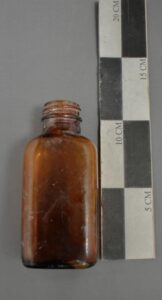 The Original Process of Glass Making
The Original Process of Glass Making
Originating 100 CE, the origins of glass blowing most likely started in Syria as glass blowers discovered how to manipulate sand by heating it and blowing it into a shape to store items. A glass-blowing shop consisted of six or seven men or children. Children usually worked ten-hour shifts. Unfortunately, glass blowing lead to many cases of burns, pneumonia, and rheumatism.
The Introduction of Machinery in the Production of Glass Bottles
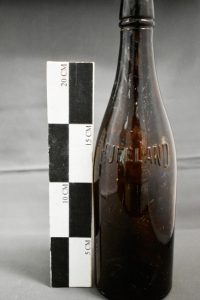 This early process of glass blowing is still used today. However, during the Second American Industrial Revolution, Michael J. Owens revolutionized the glass bottle-creating process in the 1900s. Being a man who worked his entire life in the glass-blowing industry, Owens understood the harm and damage that blowing glass caused people. With this in mind, and the prospect of making money, Owens made a model glass blower in 1903 that eliminated the necessity for blowing the glass to give it shape.
This early process of glass blowing is still used today. However, during the Second American Industrial Revolution, Michael J. Owens revolutionized the glass bottle-creating process in the 1900s. Being a man who worked his entire life in the glass-blowing industry, Owens understood the harm and damage that blowing glass caused people. With this in mind, and the prospect of making money, Owens made a model glass blower in 1903 that eliminated the necessity for blowing the glass to give it shape.
The first model of the machine had six arms, which allowed for the creation of six glass bottles at a time. The machine would rotate until the bottle was completed, where it released the bottle onto a conveyor belt and was taken to an oven to complete the annealing process. Once that process was completed, the bottle would be packed for distribution. This revolutionized the glass bottle industry.
Bitters Glass Bottle Used for Digestion
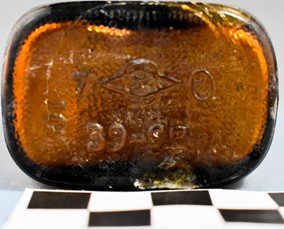
In this collection, there was a wide variety of glass bottles. This includes spirit bottles, medicine bottles, bitters bottles, and poison bottles. Bottle types ranged from beverage bottles to bottles used for nursing the sick. Some large name-brand bottles recovered were that of Coca Cola, Best Foods, and Hufeland.
This collection secondly had different companies that produced these bottles, including the most prominent being Hazel Atlas Co. and Owens-Illinois Glass Co. During the time period of this site, many glass bottles were made by hand, as they did not have the technology to produce them by machine. This shows in some bottles as air bubbles and imperfections that can be seen throughout the glass. Since plastic was not a commodity used during this time, glass bottles were the dominate form of storage for beverages and food items.
Historic Milk Glass Cold Cream and Cosmetic Jars
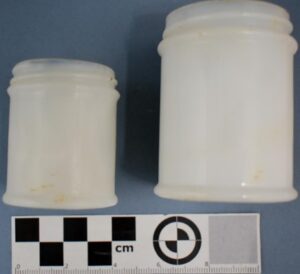 Throughout this collection, many makeup jars can be found. During this period, makeup was not used to make women more attractive but rather to enhance the beauty standard within society. Items such as cold cream, hair dye, toothpaste, and makeup were also a sign of status. With the large amounts recovered, it can be assumed that this location was of a higher class of people with a good amount of disposable income.
Throughout this collection, many makeup jars can be found. During this period, makeup was not used to make women more attractive but rather to enhance the beauty standard within society. Items such as cold cream, hair dye, toothpaste, and makeup were also a sign of status. With the large amounts recovered, it can be assumed that this location was of a higher class of people with a good amount of disposable income.
Secondly, a large amount of perfume and cologne bottles were recovered. Cologne bottles are interesting to note. During that time, cologne bottles were much larger, as with a high concentration of alcohol, they did not have the same potency effect as that of many perfumes. Cologne bottles during the time were a work of art and included many unique colors. The “milk glass” color is produced by mixing tin or zinc in the fine sand that is used to produce the glass.
Conclusion
This site shows many of the common items used by a middle-class family living in La Jolla during the historic period. It also shows the progressiveness and ingenuity of American invention and how it was very common in the lives of American people.
Written by Collections Intern Eric Walker
Edited by Collections & Library Tech Suzanne Moramarco
Project Name: Mitigation Monitoring for the Modera San Diego Project
Location: Point Loma
Year of Excavation: 2018-19
Overview of Site
Archaeological testing, monitoring, and data recovery took place in the Point Loma region of San Diego to make way for new luxury apartments. The project identified eight historic features including three refuse deposits, two brick wells, two cisterns, and one brick over foundation. This collection consists of four boxes from the 2018 artifact recovery. The boxes contain historic artifacts from 1870 to 1920.
The city block contained a mix of residential, commercial, and industrial developments from 1870 to 1920. Other than residential living, the site once held a lodging house with a saloon, a hen house, a stable park and carriage house, corral bakers, and a tannery. The historic artifacts recovered reflect these developments.
The large variety of artifacts with high numbers of household, consumer, and kitchen items indicate that the families and individuals living there spanned all economic classes. Records also indicate that most tenants only stayed for one to two years.
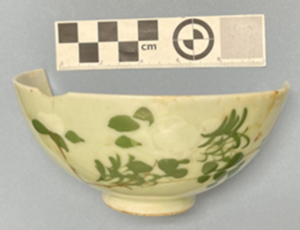 Porcelain and Ceramic
Porcelain and Ceramic
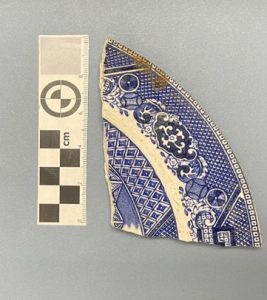 A wide variety of ceramics were found in the refuse deposits. These flatware items have many different points of origin ranging from Europe, Japan, Mexico, China, and North America. This suggests that most families and individuals brought their goods with them when they immigrated to San Diego. There was a general attraction to move to the United States because of the economic opportunity it provided foreigners. Although there was a lot of discrimination toward immigrants in a foreign land, it helped to diversify many areas in the States.
A wide variety of ceramics were found in the refuse deposits. These flatware items have many different points of origin ranging from Europe, Japan, Mexico, China, and North America. This suggests that most families and individuals brought their goods with them when they immigrated to San Diego. There was a general attraction to move to the United States because of the economic opportunity it provided foreigners. Although there was a lot of discrimination toward immigrants in a foreign land, it helped to diversify many areas in the States.
America remains a melting pot of many different ethnicities which stay alive by people bringing their culture and material goods with them to different places.
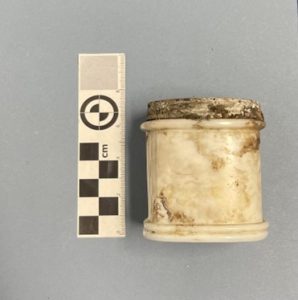 Beauty and Healthcare Products
Beauty and Healthcare Products
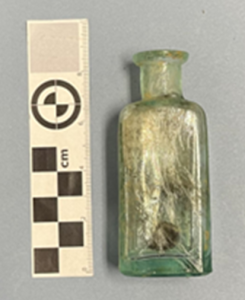 A significant amount of beauty and health products were recovered from the site. Products such as face lotion, hair dye, and perfume imply that the pressure of women’s beauty standards have been present for many years. The use of these products allowed women to follow the standard of enhancing and preserving beauty. Visible use of makeup was thought to take away or hide the natural beauty of a woman. These ideologies seem to hold true when looking at the artifacts found because there was no makeup present in the collection. Possession of these products also indicates a higher level of disposable income from the individuals that owned them.
A significant amount of beauty and health products were recovered from the site. Products such as face lotion, hair dye, and perfume imply that the pressure of women’s beauty standards have been present for many years. The use of these products allowed women to follow the standard of enhancing and preserving beauty. Visible use of makeup was thought to take away or hide the natural beauty of a woman. These ideologies seem to hold true when looking at the artifacts found because there was no makeup present in the collection. Possession of these products also indicates a higher level of disposable income from the individuals that owned them.
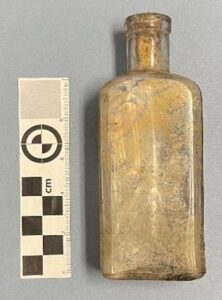 Hygiene and healthcare items were also abundant in the collection. Products such as tooth powder, pain killer, cough syrup, heart medicine, and much more were present in the collection. As in most cities in the late 1800s and early 1900s, San Diego was booming with immigrants. During this time, public health was mostly a sanitation issue in San Diego. The San Diego Department of Health was established in 1888 to try and combat many of these issues from becoming even worse. In conjunction with sanitation issues, there was a lack of hospitals, medical libraries, and laboratories at the turn of the 19th century. A wide variety of at-home tonics and patent medicines were produced and sold throughout this time. These medicines proved to be ineffective and sometimes dangerous to use. Some of the medicine bottles recovered from this site suggest the use of these at home remedies.
Hygiene and healthcare items were also abundant in the collection. Products such as tooth powder, pain killer, cough syrup, heart medicine, and much more were present in the collection. As in most cities in the late 1800s and early 1900s, San Diego was booming with immigrants. During this time, public health was mostly a sanitation issue in San Diego. The San Diego Department of Health was established in 1888 to try and combat many of these issues from becoming even worse. In conjunction with sanitation issues, there was a lack of hospitals, medical libraries, and laboratories at the turn of the 19th century. A wide variety of at-home tonics and patent medicines were produced and sold throughout this time. These medicines proved to be ineffective and sometimes dangerous to use. Some of the medicine bottles recovered from this site suggest the use of these at home remedies.
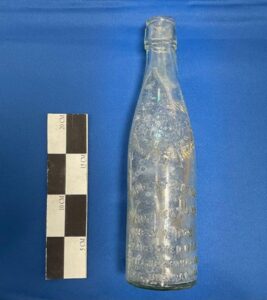
Food and Beverage
A bulk of this collection consisted of food and beverage jars and bottles. There were many alcohol bottles, dressings, spices, sauces, and dairy products. The average American adult drank about 2.5 gallons of alcohol per year until around 1916 when the national average took a dip to about 2 gallons a year. The most common drink was whiskey because it was significantly cheaper than beer, wine, or other drinks. In this collection, there was a wide variety of beverages of varying price points. This confirms that the individuals and families living here span all economic classes. This wine comes from the vineyards at a Mission in Rancho Cucamonga. However, the text on the bottles indicate that it is from Brookline, New York because it was shipped and bottled there. The Virginia Dare Winery was named after the first Christian child born in the New World.
Conclusion
This collection allows for a glimpse into San Diego history in the late 19th century and early 20th century. It shows the evolution of the city with its ever-changing land usage and the diversity of people living in it. Although there were multiple cultures living in the city, they all are united by the common constructs and consumer goods of the time.
By Alysa Ransom, Collections Volunteer
Further Reading
San Diego’s Medico-Legal History, 1850-1900, San Diego History Center
https://sandiegohistory.org/journal/1970/april/stanford/
The Virginia Dare Winery
https://www.thedesertway.com/virginia-dare/
Immigration to the United States, 1850-1900, Library of Congress
https://www.loc.gov/classroom-materials/united-states-history-primary-source-timeline/rise-of-industrial-america-1876-1900/immigration-to-united-states-1851-1900/
The 1900s: Medicine and Health
https://www.encyclopedia.com/social-sciences/culture-magazines/1900s-medicine-and-health-overview
Project Name: Results of Archaeological Data Recovery and Mitigation Monitoring and Reporting Program for the Sewer and Water Group Job 809, San Diego, California
Location: La Jolla
Year of Excavation: 2013-15
This collection is currently being inventoried.
Overview of Site
This site was excavated by RECON Environmental from 2013 to 2015. It includes cultural deposits from around 6000 BCE to approximately 1770 CE. Much of the collection is prehistoric, including many artifacts from the Late Prehistoric Period. The cultural affiliation is Kumeyaay and includes two sites, CA-SDI-39 and CA-SDI-20130. This site area has been excavated before and is part of the La Jolla Complex, which was first identified by Malcom Rogers in the 1930s. The collection is large and contains shell, animal bone, chipped stone tools, ground stone tools, and ceramics.
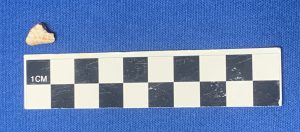
Tooth Plate
There are around 150 bones in the collection that are from the Semicossyphus pulcher, or the California Sheephead fish. Most of the bones are tooth plates and teeth. The California Sheephead fish has sharp teeth and throat plates to grind prey. This fish lives in bay/estuarine habitats in rocky areas of dense kelp beds. Approximately seventeen of the Sheephead fish bones were burnt, indicating they were used for food. They were likely caught with hooks and lines, but they may have also been caught with net traps or spears.
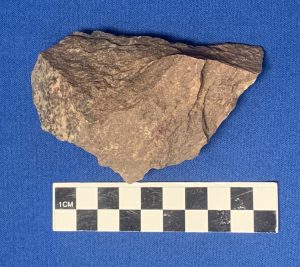
Sandstone Core
This collection contains twenty pieces of sandstone, including one core. A core is a type of raw material that is chipped at to make stone tools. The core itself may also be made into a tool such as a scraper. The sandstone in this site is from the late to middle Pleistocene (approximately 200,000 years old). The area’s rock formation is also known as the Bay Point Formation in modern-day Torrey Pines State Natural Reserve, and it is composed of marine and nonmarine pale-brown sandstone.
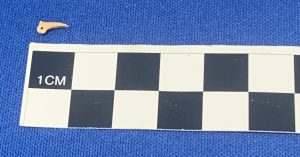
Claw
This claw is from a domestic cat or Felis catus. This species came to the United States sometime in the late 1500s with Spanish and British colonization. Cats in California would have been brought by Spanish colonizers around the 1700s. This collection contains artifacts from the 1700s so it is possible that the bone is from this period. However, this claw was found about a foot under the ground, which means it could be a claw from a modern cat as well. While cats as now commonly kept as pets, they were initially brought to North America for pest control. Attitudes about cats changed with the Enlightenment, and they started to be viewed as companions.
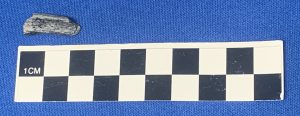
Burnt Bone
This collection contains many animal bones. Approximately thirty-eight percent of non-fish bones along with thirty-two percent of fish remains are burnt. A burnt bone often indicates cooking. Many of these bones are fragmented since burning causes bones to become brittle and break. The more charred a remain, the less likely it is to be found due to disintegration. It is also less likely to be identified, as the DNA is degraded and may be contaminated from the environment. However, burnt bones can be analyzed chemically to see the temperature at which they were burnt. This process can provide insight to the purpose or cause of the burning.
Conclusion
This large collection gives an idea of how people in the Prehistoric Period lived in La Jolla. It also gives some insight into the Late Prehistoric Period and Historic Period. This area in La Jolla has given archaeologists cultural context for nearly a century and continues to be a valuable cultural resource.
By Rembrandt Winckler, Collections Intern
Further Reading
The Wonderful World of Animal Bone and Shell, San Diego Archaeological Center
https://sandiegoarchaeology.org/the-wonderful-world-of-animal-bone-and-shell/
Rock Formations, Torrey Pines State Natural Reserve
https://torreypine.org/nature-center/geology/rock-formations/
Uncovering the Chemical Secrets of Burnt Bones, Chemical and Engineering News
https://cen.acs.org/analytical-chemistry/forensic-science/Uncovering-chemical-secrets-burned-bones/96/web/2018/10
How the Enlightenment Transformed Cats into Pets
https://livesandlegaciesblog.org/2018/03/16/how-the-enlightenment-transformed-cats-into-pets/
Spindrift Archeological Site
https://gellens.com/news/spindrift-archaeological-site-san-diegos-ancient/
Project Name: Archaeological and Paleontological Investigations in Support of the New San Diego Courthouse Project
Location: Downtown San Diego
Year of Excavation: 2014-15
Overview of Site
AECOM conducted monitoring and excavation to remove all artifacts in the area prior to the construction of the new San Diego Courthouse, located on the ancestral homelands of the Kumeyaay people, at the intersection of B Street, C Street, State Street, and Union Street.
During excavation, eleven different features of historic artifacts were discovered, primarily consisting of residential debris such as glass bottles, porcelain fragments, and small metal objects. One feature was a well containing glass bottles, household items, kitchen items, and personal items.
Several of the recovered bottles were commercial, medicinal products of which the purpose and ingredients seem outrageous by today’s medical standards. They show both a cultural shift in terms of commercial pharmaceuticals but also how far we have come in terms of medical knowledge.
Dr. Miles New Heart Cure and Restorative Nervine
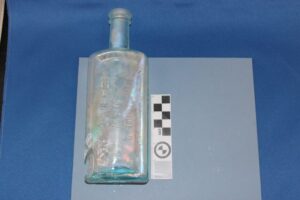
According to an 1894 publication of the Ann Arbor Register, Dr. Franklin Miles was revered as one of the leading doctors in diseases of the brain, heart, and nerves at the time. Through what is described as “careful investigation”, Miles developed two commercial tonics: one for heart disease and one of the nerves.
In the 1800s, anything that was for “the nerves” is referring to conditions such as sleeplessness (insomnia), nervousness (anxiety), dizziness, and “hysteria”. The active ingredient in the nerve tonic was bromide, which was once used as a sedative but has since been proven to have several negative effects on the body. One such effect was Chronic Bromine Intoxication. Known for causing mania in humans, bromide resulted in an uptick in admissions to mental hospitals. The second active ingredient was a “touch of chloroform”, which is an extract of opium. The nerve tonic was a very strong sedative which proved to do more harm than good for people suffering from these conditions.
Dr. Kilmer’s Swamp Root Kidney Cure
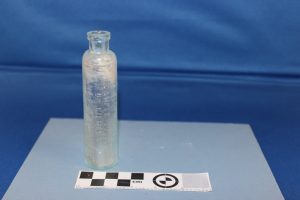
Dr. Kilmer & Co. (like Dr. Miles) became an entire brand associated with one doctor during the late 1800s. By 1885, he had a line of herbal medicines such as Indian Cough Cure, Female Remedy, and the most famous, “Swamp Root Kidney Cure”, which was available on pharmacy shelves until 1969. The drug went through several names, ultimately becoming “Dr. Kilmer’s Swamp Root Kidney, Liver & Bladder Remedy” after a 1906 act banned use of the word “cure” on medicine bottles.
The ingredients of this medicine are said to have diuretic and immunity boosting properties and have been used in traditional Native American medicine for thousands of years. Ingredients include goldenseal root, skullcap leaves, venice turpentine, peppermint, cinnamon, valerian root, and sassafras. Despite Euro-Americans removing Native Americans from their land and attempting to wipe out their culture, they were still willing to use their medicinal knowledge for their own well-being.
Conclusion
This collection shows the increase of commercial products used in San Diego towards the end of the nineteenth century particularly with pharmaceuticals. The objects discussed here not only demonstrate how medicine has advanced but also the value in traditional and herbal medicines.
By Jordan Smith, SDAC Intern 2022
Further Reading
Dr. Kilmer’s Swamp Root – Museum of Healthcare at Kingston
https://mhc.andornot.com/en/permalink/artifact7205
Ann Arbor Register – October 25, 1894 publication
https://aadl.org/node/535600
Nervine and Knavery: The Life and Times of Dr. Miles Medical Company
https://www.ftc.gov/sites/default/files/documents/publicevents/resale_price_maintenance_under_sherman_act_and_federal_trade_commission_act/rperitz_drmiles.pdf
Project Name: Celadon at Ninth and Broadway
Location: East Village, San Diego
Year of Excavation: 2013-14
This collection is currently in the curation process.
Overview of Site
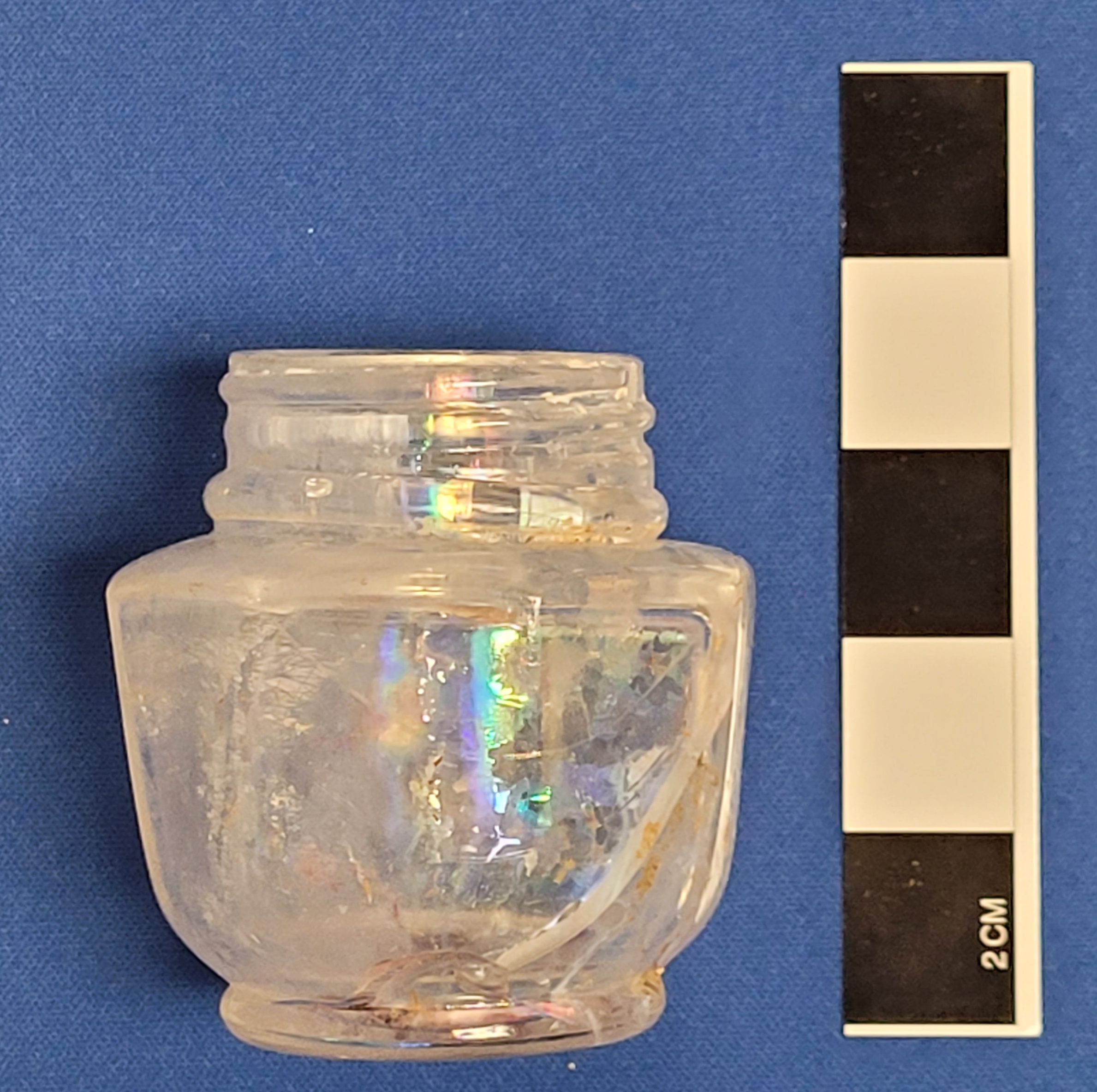
Statistical Research, Inc., conducted monitoring and artifact recovery from this site in San Diego’s East Village at the corner of Ninth Street and Broadway. The site consists of three historic features, a historic brick foundation, cistern, and well, plus three small trash deposits.
![]()
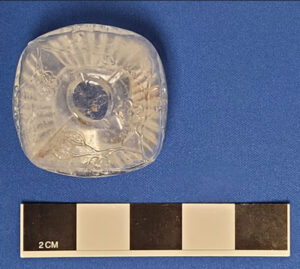
Background research indicated that the site had been in use as early as the 1870s as a residential area. Potable water was scarce in the new city, so citizens frequently turned to private wells and cisterns to obtain water. The late 1890s saw the gradual abandonment of private wells as the city began to provide an adequate water supply. The old wells and cisterns were then used as refuse dumps. The date of the abandonment of the cistern feature at the Ninth and Broadway site is not known. However, most downtown cisterns were constructed prior to 1906, before the municipal water system was extended to this area, and were abandoned before the 1920s.
The bottles and jars recovered at the site suggest a middle-class level of economic status that is typical for the period. The artifacts recovered from the site may reflect hygienic concerns in an environment with poor freshwater resources.
Perfume and Makeup
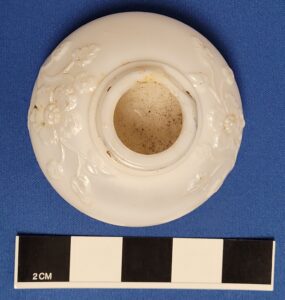
The presence of six identifiable perfume bottles and four makeup jars indicates a higher level of disposable income on the part of the inhabitants. Three of the bottles come from the northern and eastern United States. These parts of the country were well industrialized and were involved in the production of many products of the period.
The importation of beauty products from places like New York, Illinois, and Maryland may show an attempt by the new residents to live as they did in their former communities. These products also demonstrate societal norms and trends in women’s beauty standards from the Northern and Eastern United States.
Vaseline, Hand Cream, and Scalp Tonic
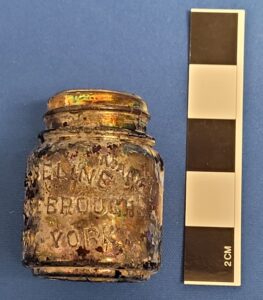
In addition to mitigating the smell caused by a lack of bathing, the new residents of San Diego had to deal with skin conditions from the dry air and flea infestations. The presence of fleas in Southern California is well documented in the accounts of early Spanish explorers. Gaspar de Portola famously named the creek inside the modern Camp Pendleton Las Pulgas, or The Fleas. This flea problem persists to this day but was a well-known fact of life for early San Diegans.
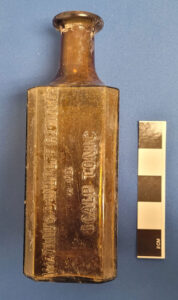
While flea bites and itchy skin were a problem for all inhabitants of the county, the people living on this site had the economic privilege to combat these issues with modern products that may have been available to the average citizen. Although not necessarily gender specific, the presence of hand cream and scalp tonic may be indicative of beauty standards for middle-class women intent on keeping up appearances in the under-developed city.
Conclusion
This collection demonstrates the changes taking place in San Diego society around the turn of the twentieth century. The new urban middle class constituted a significant portion of the peoples living and working in the developing city, and their needs and adaptations to life in San Diego are reflected in the presence of perfumes and beauty products.
by Kirk Staver, SDAC Intern
Further Reading
Cosmetics and Personal Care Products in the Medicine and Science Collections, National Museum of American History
https://americanhistory.si.edu/collections/object-groups/health-hygiene-and-beauty
General timeline of the Portola Expedition and Eighteenth-Century California History
https://en.wikipedia.org/wiki/Timeline_of_the_Portol%C3%A1_expedition
Fleas as part of the ecology of San Diego
https://www.sandiegoreader.com/news/2021/aug/02/outdoors-thunderheads-east/
Project Name: Final Archaeological Data Recovery for a Portion of CA-SDI-48, San Diego
Site(s): CA-SDI-48
USGS Quad Location: Point Loma 7.5’
Year of Excavation: 1997 and 1998
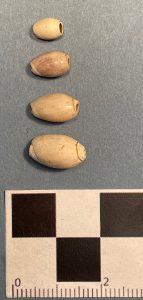
PL 04, a federal collection, is in the curation process. With inventory having been completed, the labeling of artifact bags is ongoing.
Overview of Site
Cultural resource data recovery at this site took place at two Loci, A and B. An early milling archaic component and shell midden yielded Olivella beads, bone tools, and otoliths. Historic resources were also recovered from this site. This collection consists of two boxes from a 1997 project and eleven boxes from a 1998 project.
Radiocarbon dates for several shellfish and charcoal samples from past projects verified a long-term human occupation at the site (circa 6,000-2,000 years ago). The report from the 1998 project states that the large set of dates makes CA-SDI-48 one of the best, if not the best, dated sites in southern California.
Additionally, a thorough analysis of shellfish remains, fish bone, and terrestrial faunal remains from the site has provided new insights into the life of the people of the La Jolla complex during this time.
Shell
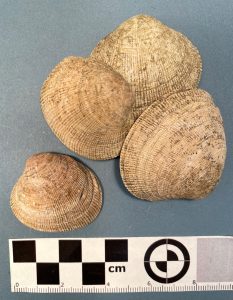
A majority of the collection consists of unmodified shell (over 169,000 g/372 lbs.). There were 48+ types of shellfish identified from bivalves (clams/mussels/oysters) and gastropods (snails) to chitons and crustaceans (barnacles/crabs). They were procured from a variety of habitats: bays and estuaries, exposed rocky and non-rocky shores. The most prevalent recovered species, Protothaca staminea (Common Littleneck clam), Chitons (mollusk), and Ostrea lurida (Native Oyster), could be found in more than one of these habitats.
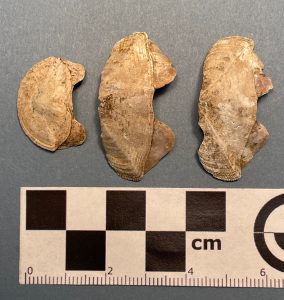
Many of the small snail types represented in the collection were probably gathered incidentally; they were attached to eelgrass or kelp and accidentally brought to the site. As such, they were not considered to have been collected as food sources. However, they do provide an idea of what activities the inhabitants were participating in at the time of the site’s occupation.
As the report states, the “variation in shellfish species at the site reflects the occupants’ abilities to roam over a large area and exploit a variety of environmental niches. The diet of the occupants was varied both in nutritional value of the shellfish, the taste, and the availability or opportunity to capture a given species”.
Faunal Remains
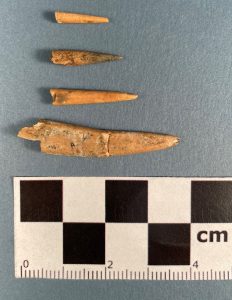
The species of fish represented in the collection show that fishing was done in the adjacent bay, kelp beds, and offshore waters. The presence of bone awls may indicate the repair of fishing nets and fishing gear. Fish bone analysis showed a high occurrence of head and facial skeletal parts, along with terminal vertebrae, which indicates that the fishermen at the site decapitated and removed the fins from the fish. They then moved the processed fish to another area for storage or cooking. The lack of burnt fish bone also shows that the site served, in part, as a fish processing camp.
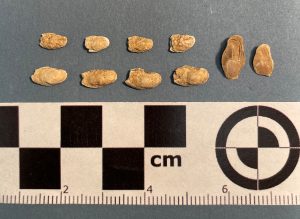
The most plentiful species of fish represented, by number of fragments, are White Croaker (485), Rockfish (307), California Sheepshead (230) and Perch (187). Studies of the otoliths (fish ear bones) found at the site indicated an abundance of fish caught in early to late summer.
The animal bone is of a much smaller quantity of the collection than the shellfish. There are 3,119 fragments, of which 82% were from small terrestrial mammals including black-tailed jackrabbit, desert cottontail rabbit, California ground squirrel, and pocket gopher. An analysis of past and current studies found that the frequency of burnt non-fish vertebrate remains on the site indicated minimal direct fire burning. This, along with little evidence of butchering, reveals a preference for cooking (probably in soups or stews) rather than roasting.
Conclusion
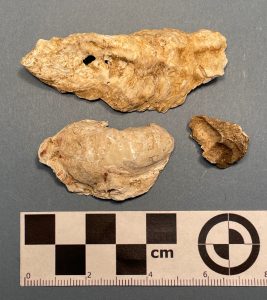
The reports shows that the information recovered from the data recovery programs at this site can be used to address important research questions and to pose new ones.
by Suzanne Moramarco, Collections and Library Specialist
For Further Reading
For further exploration into the topics mentioned above, these titles are available for checkout from the SDAC Research Library.
California Bone Artifacts (Anthropological Records), E. W. Gifford
Californian Fish Spears and Harpoons (Anthropological Records), J. A. Bennyhoff
A Key to Some Southern California Fishes Based on Vertebral Characters: Fish Bulletin No. 79, Charles R. Clothier
Marine Fish Osteology: A Manual for Archaeologists, Debbi Yee Cannon
Seashore Life of Southern California, Sam Hinton
Shell Bead and Ornament Exchange Networks Between California and the Western Great Basin, James A. Bennyhoff and Richard E. Hughes
Funded in part by the City of San Diego Commission for Arts and Culture and the County of San Diego

